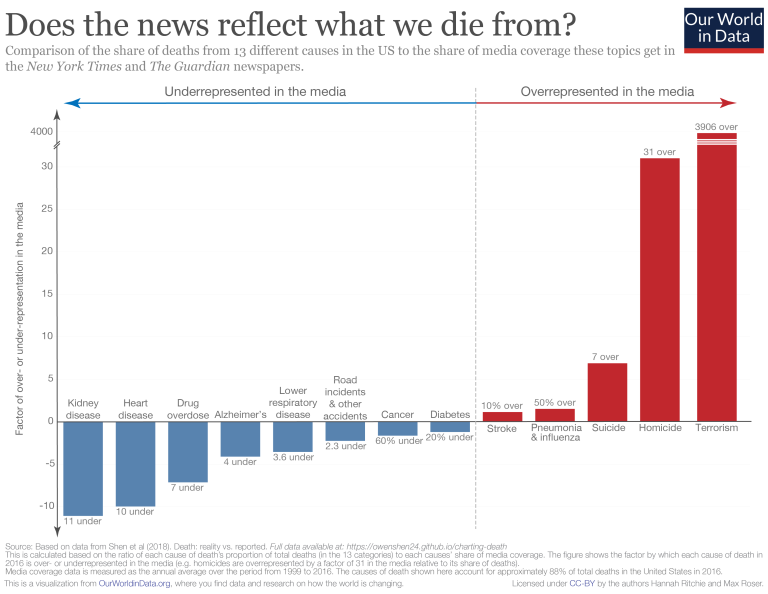
A report from Our World in Data1 focuses on Google search queries and their relationships to U.S. death statistics from the Centers for Disease Control and Prevention (CDC), as well as appearance in popular media, including mentions of causes of death in the New York Times and the Guardian newspapers. The report indicates that few people are scanning the internet for information on the condition that most likely will lead to death.1
Violent forms of death, including suicide, murder, and terrorism, comprised 22.8% (the largest portion) of Google searches in 2016.1 Media coverage of that category also was dramatically high; more than 75% of stories pertained to violent deaths. However, violent forms of death comprised less than 3% of actual U.S. deaths in that year. The most underrepresented cause of death covered in the media was kidney disease, which contributed to 2.7% of annual deaths but reflected only 0.2% of internet searches.1

Other types of death were more evenly distributed in Google searches and media coverage and reflect reality more accurately. For example, stroke leads to approximately 5% of deaths and made up a similar share of Google queries and news coverage, according to the same report.1
In general, Google searches appear to more closely match real-world causes of death, but there is a large discrepancy between actual causes of death and the media’s coverage of those causes. According to the study’s author, it is possible that exposure to health information encourages people to take preventative action, thereby reducing related deaths. The nature of media coverage has become increasingly fast-paced, focusing on big events and captivating stories, which broadens the divide between news coverage and reality. However, there remains some inherent bias in the public’s health-related concerns: Although most people die of heart disease, only a small minority seek related health information online.1

According to 2017 data from the CDC, the 10 leading causes of death (from greatest to least) are heart disease, cancer, unintentional injuries, chronic lower respiratory diseases, stroke, Alzheimer’s disease, diabetes, influenza/pneumonia, kidney disease, and suicide.2 Even though heart disease tops the list and is responsible for roughly a third of all deaths, the Our World in Data report showed that this condition represented only about 2% of web searches. Moreover, media coverage also was skewed, with heart disease making up only 2.5% of news stories.1 Clearly, Americans do not know what truly ails them.
Heart disease constitutes a range of conditions, including coronary artery disease, arrhythmia, heart failure, and myocardial infarction. It is the leading cause of death for both men and women of nearly every ethnicity. The key risk factors for heart disease are smoking, hypertension, and hypercholesterolemia – and nearly half of all Americans have at least one of these risk factors. Heart disease also contributes to the growing rates of diabetes, obesity, physical inactivity, poor diet, and alcohol use.3
ECG monitoring: a solution to detect the #1 killer
Computerized electrocardiography (ECG) monitoring is a crucial tool to care for people with heart disease who are at risk for ischemia, arrhythmia, or myocardial infarction. However, traditional single lead ECG monitoring provides only a brief snapshot of a section of the heart function; it does not capture dynamic changes in the heart, and this can result in missed episodes of ischemia. In general, using more leads in arrhythmia analysis as well as ST monitoring in all 12 leads - like with the GE Healthcare 12SL algorithm - will yield more reliable arrhythmia interpretation.
GE Healthcare’s continuous ST-segment monitoring solution can help clinicians detect potentially life-threatening conditions, investigate the causes, and potentially start treatment sooner. The GE Healthcare system allows for multi-lead or single-lead analysis and provides views of the heart’s electrical activity from two planes, frontal and horizontal, which may be essential for detecting arrhythmia.
References
- Ritchie H. Does the news reflect what we die from? Our World in Data. May 29, 2019. https://ourworldindata.org/does-the-news-reflect-what-we-die-from?linkId=68864855. Accessed July 14, 2019.
- Murphy SL, Xu JQ, Kochanek KD, Arias E. Mortality in the United States, 2017. NCHS Data Brief, no 328. Hyattsville, MD: National Center for Health Statistics. 2018. Accessed July 14, 2019.
- Heart Disease Facts. 2017. https://www.cdc.gov/heartdisease/facts.htm. Accessed July 14, 2019.







